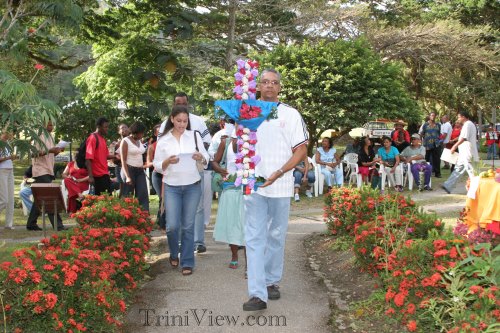 The procession of the cross at Cruz de Mayo
The procession of the cross at Cruz de Mayo
A compilation by the Venezuelan Institute for Culture and Co-operation
May 29, 2006
It is believed that the celebration of the May Cross, which appears officially on the 3rd May on the Catholic Calendar, is primordially of pagan origin. The peoples of old Europe would adorn a young girl with flowers in commemoration of the goddess Maya or Maia (May) the goddess responsible for the splendour of nature. She was also called Flora in some cultures. This goddess represented eternity as spring is the time of renewal and it occurs every year brand new again without fail. They would celebrate, dancing around a log which was eventually replaced by the Christian Cross and its accompanying rites. However, the pagan May Pole celebration still survives today and research has pointed to Catalonian origins, not English. The fact that the Catalonians and Basque people were there even before the Romans lends credence to this postulation.
The Christian legends behind the Santa Cruz are many. The first one points to the discovery of the true cross by Constantine’s mother, Saint Ellen. Constantine, the Emperor that allowed Christians to practice their religion freely, had a dream one night before the battle for the Danube, which took place during the sixth year of his reign. In the dream he kept seeing the Cross and the words "With this sign is your victory." The very next day he had a cross made and set out to battle, defeating the barbarian horde that vastly outnumbered his army.
He trusted his mother with the mission to find the true cross of The Christ and she immediately set out to Jerusalem. Upon arriving at the sacred city she consulted the wise men who took her to the place where Christ was crucified. However, there were three crosses there covered in blood. To find out which was the true cross, she had the ill, the broken and even brought in the dead, who were all cured and restored to life upon coming into contact with the true cross. Veneration of the cross was born from there.
Another story tells of the sacking of Jerusalem and the theft of the sacred relics by the Persians. The emperor at that time, Heracles, defeated the Persians and rescued the Cross. He attempted to restore it to its place on the Place of the Skull [where Jesus Christ was said to be crucified by the Romans]. He summoned his entourage and they were all in magnificent robes and finery, and with every step forward the Cross became progressively heavier. Consulting the Patriach of Jerusalem he was advised to go as Christ did, humble and likened unto a beggar. This advice he took and managed with consummate ease to place the cross back into the Church of the Holy Sepulchre, a church erected on the site.
It is said that in order to avoid the theft of the cross and to avoid this power in the hands of one person, it was divided up. One log sent to Rome, one to be kept in Jerusalem, one in Constantinople and various pieces to churches worldwide in places that carry the name "Veracruz."
Spain herself is purported to have two pieces in Merida and Guadix, hence the special devotion to the Santa Cruz (sound familiar?) by Spaniards.
When the celebration of the May Cross reached the Spanish Americas, notably Venezuela and Trinidad, it was mixed with the Amerindian and African joy of life and reverence for nature to become the colourful and beautiful Velorio de la Cruz de Mayo or Cruz de Mayo or Cruz which we will be celebrating in Lopinot on the 28th May, 2006.
Also Read:
Cruz de Mayo 2006 in pictures:
www.triniview.com/gallery/main.php?g2_itemId=133578
Homepage | Lopinot | Special Events | Photo Gallery
|
